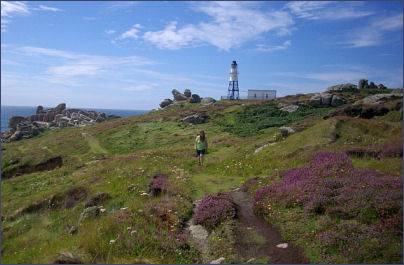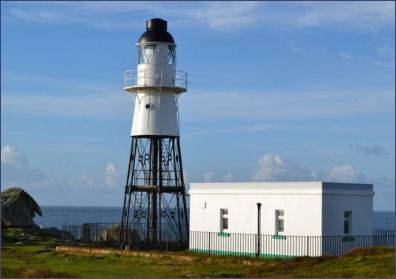OS grid reference :- SV 911095
 Imposing and dramatic Peninnis Head is the southernmost point of the Island of St. Mary's, the largest of the Isles of Scilly.
Imposing and dramatic Peninnis Head is the southernmost point of the Island of St. Mary's, the largest of the Isles of Scilly.
The wild and rugged promontory, a designated Site of Special Scientific Interest (SSSI) is littered with granite rocks and boulders which have been eroded by the action of the wind and pounding waves into fantastic shapes. These include the rock formation known as the Kettle and Pans, which lies around 100 yards north of Peninnis Lighthouse, where immense basins have been hollowed out by the elements
.One particular huge rock formation resembles a giant double molar, while to the left of it stands a canine shaped rock appropriately named Tooth Rock. Nearer to the Lighthouse there are several other named rocks, including the Witch's Head, the Pulpit Rock, the Giant's Foot, Walrus Rock, the Laughing Old Man, Sleeping Bear, Toast Rack, Tuskless Elephant and the Nubian's Head.
To the south of the Lighthouse, towards the sea, lies the Great Jolly Rock, a vast area of flat topped rock inclining towards the land. It was on this rock that the Minnehaha, sailing from Falmouth to Dublin with her cargo, was wrecked in January 1874. The Captain and nine crew members all perished.
 The Logan Stone of Peninnis Head is situated amongst the labyrinth of rocks below the lighthouse. The stone is difficult to detect but the top of the Logan Stone can be spotted from the foot the lighthouse, looking to the south. It was discovered in 1893 when a native of St. Mary's was caught by a sudden squall on the headland and sheltered in a crevice in the rocks. To his consternation, he suddenly felt the solid rock against which he was leaning, move, and more remarkable still, discovered that it could be rocked with a slight exertion of strength. The stone is around 15 feet high and is estimated to weigh 313½ tons.
The Logan Stone of Peninnis Head is situated amongst the labyrinth of rocks below the lighthouse. The stone is difficult to detect but the top of the Logan Stone can be spotted from the foot the lighthouse, looking to the south. It was discovered in 1893 when a native of St. Mary's was caught by a sudden squall on the headland and sheltered in a crevice in the rocks. To his consternation, he suddenly felt the solid rock against which he was leaning, move, and more remarkable still, discovered that it could be rocked with a slight exertion of strength. The stone is around 15 feet high and is estimated to weigh 313½ tons.
The headland and surrounding heath is carpeted with colourful gorse, heather, thrift and bell heather. Unusual in the Scilly Isles, spring squill (Scilla verna) and thyme(Thymus polytrichus) can also be found there. On the banks of Peninnis Head is a sea cave known as Piper's Hole.
Four prehistoric cairns are to be found on the headland which are in various states of preservation.
Peninnis Head can be reached by following the south path from Hugh Town's Porthcressa Beach.
Image 1 copyright Bob Embleton
Peninnis Lighthouse
 At the tip of Peninnis Head stands a rather squat automatic lighthouse constructed in 1911 by Trinity House to replace the more impressive seventeenth century lighthouse on St Agnes, which had been in operation since 1680.
At the tip of Peninnis Head stands a rather squat automatic lighthouse constructed in 1911 by Trinity House to replace the more impressive seventeenth century lighthouse on St Agnes, which had been in operation since 1680.
The building, which is Grade II listed, consists of a 14 metre high metal tower, which emits a white flash every 20 seconds. The light helps vessels to safely navigate St Mary's Sound and enter Hugh Town harbour.
The upper part of the tower (comprising gallery and watch room) is painted white and the lower part and cupola painted black. There is an adjoining one-storey building for storing equipment.
The lighthouse was re-engineered and converted from acetylene gas to electrically powered operation in 1992.